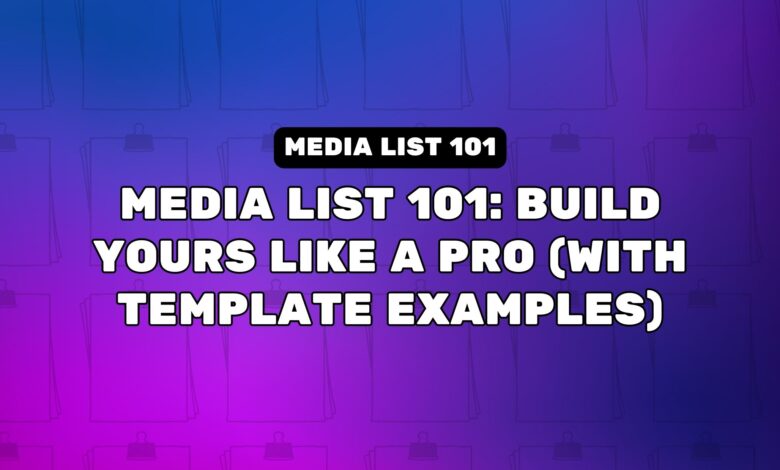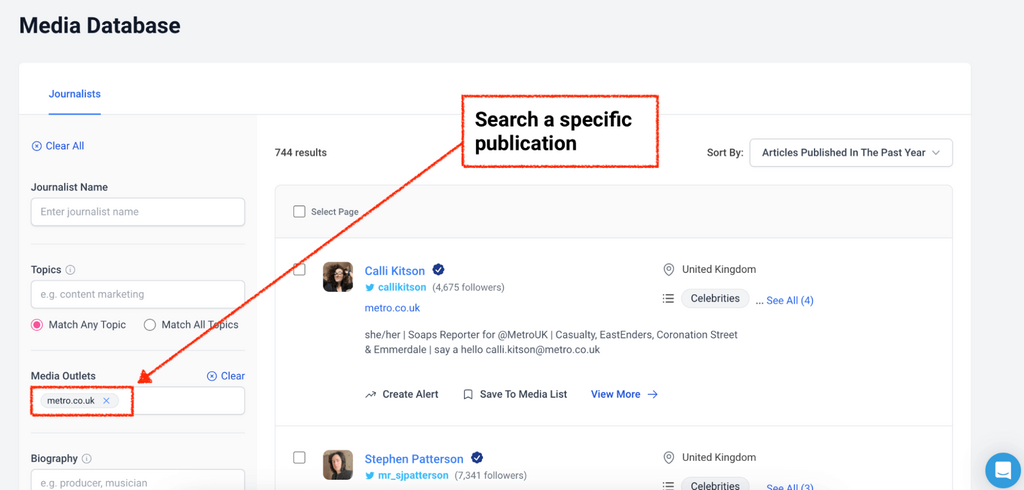Media List 101: Build Yours Like a Pro (With Template Examples)

Struggling to get your pitches noticed? Crafting a solid media list is key to getting your story in front of the right journalists. This handy guide will show you how to research, organize, and update your press list so that you can land a home-run with your coverage.
What is a media list?
A media list is a document or database that contains information about the journalists, bloggers, influencers etc. who cover yours or your client’s niche.
It helps you prioritize your outreach, with the view to earning press coverage.
Your media list, sometimes known as a press list, should be specific to your (or your client’s) industry niche or location, unless you’re pitching to national or international publications.
What does a media list include?
A media list shouldn’t just be a directory of journalist names and contact details.
You can take that approach… if you want to stay firmly on read.
Instead, think of media lists as being a place you record key journalist information that can help you better craft and schedule your pitches.
They should be the result of deep research into a journalist’s content, and how they operate.
A media list should include the following, key criteria:
- Contact details (predominantly their email address)
- Full name
- Main publications (many journalists write for multiple publications)
- Role (eg. journalist, reporter, data journalist etc.)
- Beats and topics covered (eg. nutrition, Crossfit, paleo etc.)
- Social media handles
- Relevant past content
For a deeper-dive on what to include in your media list, head to 5 steps for building a targeted media list.
Digital PRs often have a rolodex of key media contacts that they’ve built trusted relationships with, but this is especially important for those doing consistent PR for the same brand/group of brands (eg. in-house PRs).
If you’re one of those PRs who intends to pitch the same media contacts on an ongoing basis, you want to pull as much information as you can into your core media list.
On the flip side, if you’re building a press list for a one-off campaign, you can be a bit more selective with your list criteria, depending on your campaign’s specific goals.
Generally speaking, you can create three different types of list:
- Core media list: The media contacts you’re invested in building close working relationships with over time.
- Press release media list: A wider list of, usually, industry-specific journalists who are likely to cover your business news.
- Campaign media list: A list of journalists who will get value out of covering your specific campaign.
There can, of course, be crossover between all three of these lists.
Here’s an example of how Iona Townsley, Founder of Heroine PR, builds her media list, based on the markets she operates in.
And Katy Powell from Bottled Imagination does the following when it comes to building her media list:
- Reviews past media lists to find relevant journalists, and checks they’re still active.
- Reuses evergreen media lists (featuring journalists she has already established a relationship with) for yearly or seasonal PR – eg. gift guides.
- Builds media lists from scratch for unique campaign ideas, to account for industry shifts and journalist personnel changes.
- Prioritizes contacting major publications first, then works her way down to niche publications.
- Groups contacts by niche within the broader industry – to better tie pitching angles directly to what journalists cover – eg. separating lifestyle from health journalists.
- Leaves article notes on her media list, detailing specific content that the journalist has written, to demonstrate their relevance for pitching.
Buying vs building a media list
You can buy pre-built media lists from vendors, but often these paid lists can be:
- Expensive
- Out of date
- Not relevant to your story
Building your own media list can take time and effort, but it allows you to tailor the list to your specific goals.
It also gives you confidence to know that you’re pitching not only the right reporters, but the ones who are active at the point of pitching.
The perceived benefit of paying for a media list is the time it can save you.
But from personal experience, I haven’t seen that being the case.
I have been shared on a – not necessarily paid – but pre-built media list for my own niche.
At the time I thought: “Great. I can get on and start pitching.”
But when I got to writing those pitches I soon realized that, even within a small niche, there’s a whole lot of nuance.
It might sound like a “No 💩Sherlock” moment, but journalists with the same overarching beats have very different styles of writing and stories to tell.
And it took me assessing each journalist on the list to work out that probably none of them would care what I had to say.
The time it took to do that could have been time spent researching the right journalists that would care.
Instead, I’d lost hours and was back to square one.
Some PRs might not let this kind of thing worry them, and would send the pitch out regardless.
But that kind of approach goes hand in hand with old-school, spammy “Spray and pray” PR tactics.
Journalists say the number one thing they need to see from a pitch is relevance.
If you want to get coverage, you need to listen to them, and invest time in building your own media lists.
What makes for an effective media list?
A media list is only as good as the coverage it’s able to generate.
We have written a bunch about what you need to do to effectively pitch journalists, but here are some key things to include in your press list:
- Recent research and fresh contact/content information
- Personalization notes
- Relevant journalist content to reference
- Data to prove that your story will earn a journalist engagement
- A journalist’s past headlines to mirror in your subject line
- A journalist’s social media accounts to check their latest activity, opinions, and pitch preferences
Best tools to build a media list
Our media database was built to help you cover every stage of your outreach: from campaign ideation to coverage.
It gives you the best bang for your buck of any media list tool out there, and saves you a whole lot of leg work in researching, qualifying, and pitching journalists.
If you don’t have the budget for a paid tool, you can still build a media list, but you will need to spend more time trawling through different sources and might not always easily find the information you’re looking for.
Here are some other free and paid tools you can use for different stages of your media list building.
Tools for finding journalists
| Tool | Free or paid? | Example use case |
|---|---|---|
| X (FKA Twitter) | Free | Find journalists via the hashtags #journorequest, #journalistrequest, or #PRrequest |
| Google & Google News | Free | Find journalists that accept expert commentary via Google News by searching “according to” then add your “keyword” topic |
| Free | Search a journalist related job title on LinkedIn to find journalists in your immediate network – through 1st, 2nd, and 3rd tier connections. These people are likely to push out content relevant to your industry. |
Tools for finding publications
| Tool | Free or paid? | Example use case |
|---|---|---|
| SparkToro | Free for 20 searches a month | Search your campaign topic in the “My audience frequently talks about” search, then hit “Press” to see the press publications they most frequently engage with. |
| Ahrefs | Paid – Starts at $133 p/m on an annual contract, for access to Content Explorer | Search your topic in the Content Explorer & hit “Websites” for a list of top ranking blogs and publications. |
| SimilarWeb | Free | Search a publication you already want to target, and check their competitor publications with the highest similarity score for more pitching options. |
Tools for finding journalist contact information
| Tool | Free or paid? | Example use case |
|---|---|---|
| X (FKA Twitter) | Free | Check a journalist’s X bio for email addresses, as many willingly offer them up. |
| Publication contact pages | Free | Check the contact us page of the publication you hope to pitch – they often tell you specifically how to pitch and which editors to contact. |
| Rocket Reach | Free | Set up an account and search a journalist’s name to find their contact details – but bear in mind your free searches are limited. |
Tools for building your actual list
| Tool | Free or paid? | Example use case |
|---|---|---|
| Google Sheets & Looker Studio | Free | Compile all your press list research into a Google Sheet. Then make it look pretty using Looker Studio ✨ |
| Airtable | Free for up to 5 editors | Record your media list criteria in Airtable, and assign it to a specific campaign. Upload all your campaign/pitch assets to the system and work collaboratively. |
| Asana | Free for up to 15 editors | Build your media list and map your pitching and coverage onto a calendar. Collaborate with up to 15 others, and push through status updates on your PR. |
5 steps for building a targeted media list
1. Get to know your audience
The aim of any PR’s game is to get in front of potential customers.
But before you can work out which press they’re consuming, you need to know who they are.
Just like any other content strategy, you should start off by trying to get inside the mind of your audience.
- Find the social platforms they congregate on
- Find the communities they engage in
- Find the topics they care about
- Find out what they search
- Find out which publications they read
Once you know exactly who they are, you can begin to discover the types of content and publications they’re most interested in.
And from there, you can find the journalists creating content your audience resonates with, and include them in your media list.
2. Decide what you need to include based on your goals
Earlier on in this article we looked at the key information to include in your press list – but no two brands share the same goals.
And for that reason, no two media lists will be the same.
To help a journalist tell a story they want to tell, while also being mindful of your own goals, you need to add extra detail to your media list.
Do you have global coverage targets?
Then you’ll probably be pitching journalists in different time zones.
Adding local times to your media list will help you pitch individual journalists at the right time for them.
Or maybe you’re going to measure your PR primarily on reach.
If so, prioritize journalists who drive the highest topic-specific engagement in your media list.
Media lists in BuzzSumo
This might sound quite a “You-centric” way of building a media list, but knowing this information will also please journalists.
Take the examples above.
Emailing journalists at a time when they’re most receptive will be appreciated – emailing them after work hours will not.
And giving journalists fresh angles on their top-performing stories?
I don’t know any journalist who would have an issue with that.
Here are some other things to include in your media list, based on your goals.
Extra criteria to include in your media list:
- Recent and popular content (ie. to know what they’re writing about right now)
- Journalist performance metrics (eg. avg engagement, publication tier, avg links/syndications)
- Publication performance metrics (eg. search share for campaign topic)
- Notes (eg. interests, style of referencing, if there’s an existing relationship etc.)
- Headline style and content type (eg. studies, interviews, localized content – you can replicate this in your campaign and subject line)


- Emotion they most commonly evoke (ie. anger, amusement, love etc.)
- Pitch preferences (eg. on their preference towards email, DMs, or contact forms, if they share them via an X post or their bio)
- Location (eg. country or region)
- Local time (eg. EDT or GMT)
- Languages spoken
3. Pick the format, layout, and tool
Before you start building your list, think about what you want from it.
Do you use a few different tools?
You might want to pool all your data, and build a Looker Studio report.
Or maybe you want to track your media list progress in one place.
In that case, a collaborative workflow management tool could be right for you.
If you want somewhere to research, discover, and outreach journalists in one place, our database might be right for you.
Using BuzzSumo’s full Media Database means:
- Finding the right contacts based on all different kinds of use cases (ie. by publication, beat, location etc.)
- Dissecting journalist content and performance with five years worth of archives and trillions of links and engagement data.
- Creating AI-assisted, hyper-personalized pitches to send to your media lists.
- Analyzing outreach with reports on opens, clicks, and forwards, to inform follow-ups.
4. Find and add the journalists that are right for you
Use social media platforms
Use X or LinkedIn to search journalist job titles and connect with those already on the fringes of your network.
Use a media database
Media databases are a central source of journalist information and contact details.
They make finding journalists easy – saving you the legwork.
Many databases prioritize contact information above all else, but at BuzzSumo we think this is only one part of the jigsaw.
We see journalist content as being key to landing media coverage, and help PRs forensically analyze this within our journalist database.
Do competitor research
If a journalist has already covered your competitors, chances are they’ll be interested in what you have to say.
Search their brand name in Google News to see past coverage, and bank relevant journalists to your list…
You can also search your competitor’s domain in the Backlinks Analyzer to find their most engaging coverage, and see if the author of that piece could work for you…
When it comes to competitor analysis, it pays to be proactive.
Monitor your rival’s coverage as soon as it comes in, by setting up a competitor alert in BuzzSumo or Google Alerts.
Start publication first
If you already have a publication in your back pocket, Google them and track down editors to pitch via their author profiles, or contact pages.
The Guardian, for example, has a page dedicated to pitching advice.
Alternatively, just search the publication in a database.
5. Keep your media list up to date
Here’s why you need to make sure your list is permanently updated:
- Journalists move around: Given the economy, journalist turnover is high, personnel changes are common, and editorial teams are leaner than ever. You need to have the right contact details, and know who is active at the point of pitching.
- Journalists change beat: As mentioned, teams are leaner. Journalists – both in-house and freelance – are having to pick up multiple beats, and these can change from one day to the next.
- New journalists enter the market: It’s not all doom and gloom. Publications regularly hire newly qualified journalists. Contacting new journalists will give you a great opportunity to build a long-term relationship.
If you don’t keep on top of active journalists, you risk wasting time researching and pitching dormant inboxes, or irritating journalists who no longer cover your topic.
So, how can you know if a journalist is still active?
Keep a close eye on their latest content
If you keep one eye on a journalist’s recent content, you can make a better call on whether they’re likely to see and respond to your pitch.
If they’re getting published frequently, for example, then you’re probably safe to keep them on your media list.
Knowing what they’ve recently published can also prevent common PR faux pas, like pitching them the story they’ve just written.
Follow their social activity
Many journalists are active on social media, and their posts can be a good clue as to what they want from a pitch (see paragraph above), and also what they’re working on.
Some will even notify PRs of their role or beat changes and welcome new pitches and connections.
If you have their social profiles to hand in your media list, then you can do a quick check to verify that a journalist is active.
Record OOOs and bounce backs
Paying attention to any form of bounce back will be important in keeping your media list fresh.
Often bounce backs will refer you to another journalist contact.
Consider if this person would make a relevant contact for your media list.
With a tool like BuzzSumo, your media list is a living, breathing index of forever-up-to-date contacts and content.
We push through 350K journalist profile updates a month – including bio and contact information, topics, article URLs, engagement metrics, and total number of articles.
Since your media list is part of this database, you’ll always be pitching relevant and fresh contacts.
3 media list template examples
1. Google Sheets
Here’s an example of a simple media list I created for the topic of “AI in PR”.
This was built with an export of data from BuzzSumo’s Media Database.
Note: I have censored sensitive information like email addresses.











